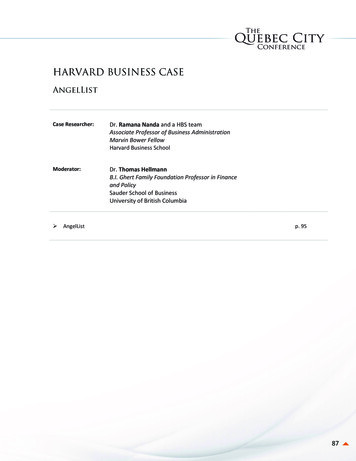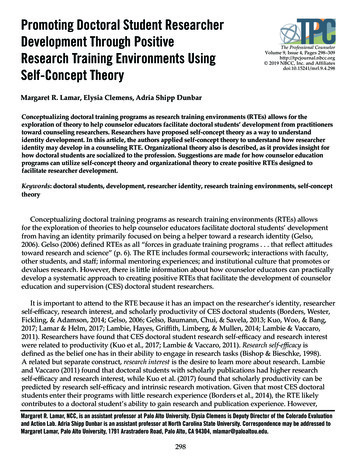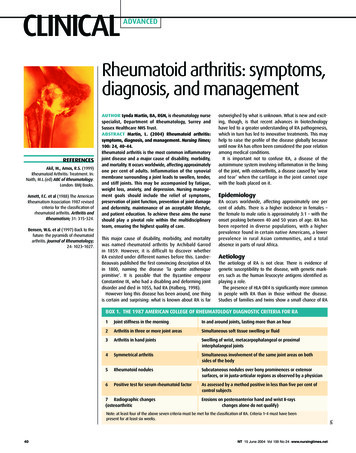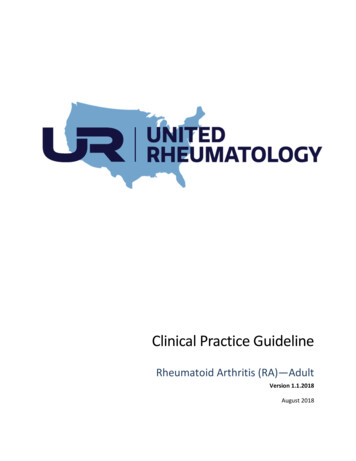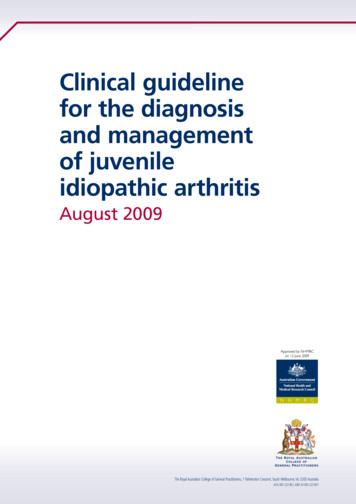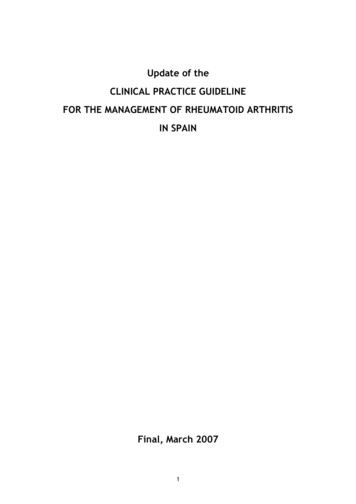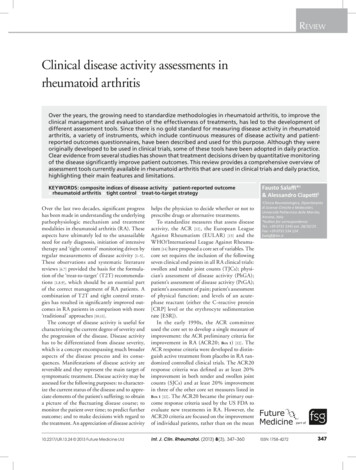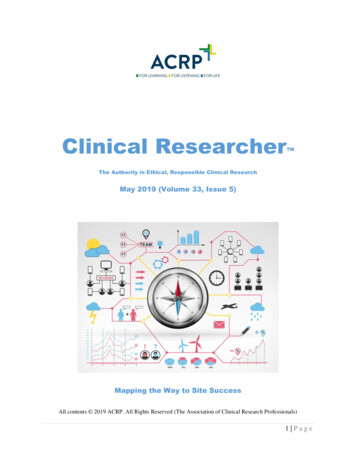
Transcription
Clinical Researcher The Authority in Ethical, Responsible Clinical ResearchMay 2019 (Volume 33, Issue 5)Mapping the Way to Site SuccessAll contents 2019 ACRP. All Rights Reserved (The Association of Clinical Research Professionals)1 Page
Clinical Researcher Association of Clinical Research ProfessionalsEditor-in-ChiefJames Michael Causeymcausey@acrpnet.org(703) 253-6274Managing EditorGary W. Cramergcramer@acrpnet.org(703) 258-3504Editorial AdvisorsSuheila Abdul-Karrim, CCRA, CCRT, FACRPFreelancerJohannesburg, South AfricaVictor Chen, MScPrincipalThe CK Clinical GroupDirector, Clinical AffairsAlign Technology, IncMountain View, CAFraser Gibson, CCRC, CCRA, CCRPPresidentAdvantage ClinicalLondon, Ontario, CanadaJerry Stein, PhD, ACRP-CPPresident/OwnerSummer Creek Consulting, LLCFort Worth, TXShirley Trainor-Thomas, MHSAPresident and Principal StrategistPhase Up ResearchMount Pleasant, SCHeather Wright, CCRCResearch CoordinatorTampa Bay Clinical Research CenterBrandon, FLStefanie La Manna, PhD, MPH, ARNP, FNP-CAssistant Professor and Advanced Registered NursePractitionerNova Southeastern UniversityLake Worth, FLChristina Nance, PhD, CPIAssistant ProfessorBaylor College of MedicineHouston, TXPaula Smailes, DNP, RN, MSN, CCRP, CCRCVisiting ProfessorChamberlain College of NursingSenior Systems ConsultantThe Ohio State University Wexner Medical CenterColumbus, OHAdvertisingTammy B. Myers, CEMDirector, Advertising & Exhibition Sales(703) .org/advertising/For membership questions, contact ACRP atoffice@acrpnet.org or (703) 254-8100.2 Page
Clinical Researcher—May 2019 (Volume 33, Issue 5)Table of Contents4 Executive Director’s Message—Thank You, James Lind!Jim KremidasPEER REVIEWED6 Three Times the Charm—Transforming Patient Centricity with eConsent, eCOA, andPatient EngagementJeff Lee17 Trial Complexity and Coordinator Capacity: The Development of a Complexity ToolAlexa Richie, DHSc; Dale Gamble, MHSc; Andrea Tavlarides, PhD; Carol GriffinCOLUMNS24 Site Strategies—Welcoming Technology into the World of Clinical TrialsMark Hanley28 Good Management Practice—Extracting Scientific and Economic Value fromClinical RemnantsChristopher J. Ianelli, MD, PhD; Andy Olen, MBAClinical Researcher is your platform. Interested in writing a peer-reviewed article or guest column?You’ll find our submissions guidelines at her/.Credit-granting Home Study tests based on Clinical Researcher articles are available for purchase athttps://www.acrpnet.org/home-study/, along with downloadable PDFs of the relevant articles andquestions from each issue. The test based on this issue should be activated online in June.3 Page
Clinical Researcher—May 2019 (Volume 33, Issue 5)EXECUTIVE DIRECTOR’S MESSAGEThank you, James Lind!Jim KremidasTwo hundred and fifty years ago, when the British empire ruled theAtlantic Ocean, Scottish physician James Lind was tasked withfinding out why scurvy was killing more sailors than Spanish andFrench enemies. Like a few others, he had a theory that addingfruit to the military diet might do the trick. For proof, in 1747 heconducted one of the first documented clinical trials.After eight weeks at sea as surgeon of the HMS Salisbury, as scurvy began to take its toll on thecrew, Lind decided to test his idea that the putrefaction of the body caused by the disease couldbe prevented with acids from fruit. On May 20, he divided a dozen sailors into six pairs, andgave each a different supplement in their diet: cider, vitriolic elixir (diluted sulfuric acid),vinegar, sea water, two oranges and a lemon, or a purgative mixture.As a result of what some have considered the first clinical trial in history, only the two sailorswho took the fruit improved. “The most sudden and visible good effects were perceived from theuse of oranges and lemons,” Lind wrote in 1753 in his historical work A Treatise of theScurvy. “One of those who had taken them being at the end of six days fit for duty The otherwas the best recovered of any in his condition; and being now deemed pretty well, was appointednurse to the rest of the sick.”4 Page
We’ve come a long way since the days of Lind, and while every day is clinical trials day in ourindustry, we like to call May 20 a special “Clinical Trials Day” and promote its celebration bystakeholders in the clinical research enterprise through events around the country, and the world.This day of celebration also provides our community with a unique opportunity to raiseawareness of clinical trials—and of clinical research as a career option—among the greaterpublic.This year we are excited to partner with PopUp Star to kick off a contest to bring clinicaltrials awareness to the masses starting on Clinical Trials Day. From San Antonio to Miami,from Las Vegas to Australia, innovative, and fun, events will educate the public about thevalue of clinical trials and the work you do every day.If you’d like to share how you celebrate Clinical Trials Day with us, please check out theACRP Facebook page at https://www.facebook.com/ACRPDC/ for details as the big dayapproaches.Jim Kremidas (jkremidas@acrpnet.org) is Executive Director of ACRP.5 Page
Clinical Researcher—May 2019 (Volume 33, Issue 5)PEER REVIEWEDThree Times the Charm—Transforming Patient Centricity with eConsent,eCOA, and Patient EngagementJeff LeeImagine seeing a product you want to buy, but whenyou go to the website, it asks you to print an orderform and mail or fax it in. Would you trust thatprovider or system with your credit card information?Probably not. And yet, that’s what we are askingpatients to do with something far more important—their health—when it comes to clinical trials. Peopleare used to technology, apps, and accessibility in theirdaily lives, so it is no surprise that a 2016 surveyshowed 31% of 137 responding patients reportedthemselves as more likely to participate in a clinical trial if it has a mobile app.{1}6 Page
In fact, Deloitte reports there are more than 260,000 health apps worldwide and the members of70% of patient groups are using at least one app to manage their condition.{2} By utilizingdigital solutions, pharma companies can tap into these progressively health-aware consumers.However, those working in the industry, specifically within clinical trials, often feel that thepatients in their studies receive a mixed experience of technology, and many simply feeloverwhelmed by too many systems.So why isn’t the pharmaceutical industry moving more quickly to adopt solutions that patients—and sites and study teams—want? Barriers to digitally focused patient centricity includeuncertainty over regulators’ expectations and requirements, and data safety and privacy concernswith the rise of medical apps and other digital technologies. Such trust issues can result inpatients being unwilling to engage with pharma, while low levels of health and digital literacyalso affect the ability to engage with patients effectively. Attracting the right talent to support apatient-centric ecosystem can also be a stumbling block, with a traditional product-based culturecausing barriers to an agile, patient-centric approach.Increased willingness to take a patient-centric approach to technology adoption to improve datacapture, patient understanding, and patient engagement is needed to drive real return oninvestment for retention, compliance, protocol adherence, and overall study timelines. The firstimportant step is improving adoption, but equally important is seamless integration and a single,unified user experience for the patient and sites. It is not enough to give them technology—itmust blend into their daily lives so that it doesn’t get in their way. In other words, we seek easyto-use solutions built with patients (and how they will actually use the tech) in mind. This articlewill therefore outline how electronic clinical outcome assessment (eCOA), electronic informedconsent (eConsent), and patient engagement apps can work together in one solution to combineto transform the patient experience in clinical trials.As an aside for readers who are concerned that their patients may lack the technologies necessaryfor the purposes described in this article, eCOA and eConsent are commonly offered usingprovisioned devices, so that all patients can utilize them, without regard to their personal mobilephone usage. Patient engagement is typically offered to patients on their personal devices, witheither mobile app (for smartphone users) or SMS (text messages) for non-smartphone users.7 Page
SMS works on any mobile phone, so this ensures that patient engagement can be provided tovirtually any patient.Creating a Seamless Patient ExperienceIn clinical studies, it is important to employ approaches that enable the optimal assessment of thestudy concepts of interest. Where this involves use of a technology solution, the aim is tosimplify processes, make participation easier, improve quality, facilitate decision making, andcollect reliable, honest data.Patients and their families are understandably impacted by technology as they are going througha trial. In a typical study, for example, one patient may experience four devices, such as awearable, a reminder app, eConsent, and an e-Diary. It is not uncommon for a trial participant toalso use a payment and reimbursement website, all accessed via different systems and devices.As new technologies emerge, they appear via specialist vendors, so for each software and device,patients have a learning curve, different access points, and compliance requirements. As a result,the patient is faced with a dizzying array of disparate communications, devices, and systems, andif the process is too complex, the patient is more likely to quit the study and deviate off protocol.Seamless integration and a single, unified user experience are again the key to makingparticipation as easy as possible without overburdening the patient. It might seem obvious, butthey only need the tools that they need.Sites today are leaning on technology help desks more than ever in their struggles to providepatients all the training they require. Fortunately, by combining these technologies into a singleproject delivery team, sites receive streamlined and coherent training, which makes them moreeffective educators to patients.However, it is not just the patient who needs to be considered, as technology has an impact frommultiple perspectives. Improving the clinical trial experience for all involved is a priority. Forstudy teams, enabling them to see real-time study progress and improve efficiencies is the toppriority for managing the complexities of a trial and not adding to it. Transparent, real-timeinsight is the key here. Meanwhile for management, any solution should improve oversight,efficiencies, and successful outcomes for return on investment.8 Page
Less Vendor Focused, More Solution FocusedAs mentioned, seamless patient experience requires successful collaboration across manydifferent areas of a trial—outreach, recruitment websites, screening, verification, eConsent,registration, data collection, data return, and incentives. How to bring all these elements togetherneeds to be considered carefully, especially in a virtual trial where there may be no physical site.Figure 1 demonstrates what successful collaboration could look like.Figure 1: Coordination Among Multiple Systems Sets a Higher Bar for a Seamless PatientExperienceeConsent, eCOA, and patient engagement solutions are the cornerstones of a dependable,patient-centric technology solution to help improve the speed, reliability, and insight of clinicalresearch. Combined into an integrated solution, it makes for a powerful approach.9 Page
eConsentPatients need to be informed and retention starts on the right foot through the informed consentprocess. eConsent sets the patient up to fully understand the study well, and the engagementaspect carries them forward. eConsent incorporates patient-friendly features such as familiar andconvenient mobile devices, multimedia video education, pop-up glossary terms, digestibleelectronic consent form sections, clearer assessments, and enhanced accessibility (i.e., audionarration, large fonts, etc.). There is a growing body of evidence to support the idea thateConsent improves patient comprehension and study retention. One study{3} demonstrated anincrease in assessment understanding with eConsent education; meanwhile, CenterWatch{4}highlighted that it is possible to enroll 25% fewer patients to reach the same completion goals aspaper-based studies. In addition, consent-related deviations are the second most common auditfindings (e.g., people consenting on the wrong version, not re-consenting to new protocolamendments, etc.). eConsent practically eliminates these deviations and improves compliance,thus delivering major benefits in time and cost at the end of a study.The benefits also extend to study teams, offering advantages such as real-time consentmonitoring, bring-your-own-device (BYOD) implementation, SaaS content system creation(with customers configuring their own programs rather than relying on the platform provider forimplementation services), eSignature, print-to-sign functionality, and a fully validated solutionthat provides value anywhere in the world.eCOA/ePROWith patient engagement–focused eCOA and electronic patient-reported outcome (ePRO, inwhich patient surveys are collected to help assess responses to the therapy that can’t be measuredby lab tests) technologies, the patient has a better experience within the study, which underpinsthe ultimate goal of capturing the most reliable data and achieving higher retention rates andimproved protocol compliance. Whilst a paper-based option could seem easier for patients to useto record information whenever needed, eCOA forces them to respond correctly, with guided10 P a g e
responses, and only during the times specified by the protocol, thus preventing “junk data” frombeing entered at whim or convenience and misleading sponsors.Access to reminders about personalized medications, appointments, and other study-specificdetails, benefiting from a single, mobile touchpoint that integrates study commitments into theirdaily life, are extras that increase engagement among patients. Content libraries presented indigital form, including video, PDF, audio, images, and text, can also facilitate comprehensionand help keep the patient fully informed about the study. Bringing these together is an importantway to guide patients through their study experiences—giving them the information they need allin one place. This is crucial in a virtual study, which offers less “hand holding” to patients fromthe site, making the reliance on technology more important.Patient EngagementEngaging a patient on a mobile device may drive better patient outcomes, compliance, changebehaviors, etc. In the arena of mobile health, it is obvious that technology is vital, but it isimportant to look at the tools in terms of the value they deliver. Effective patient engagementsolutions should eliminate the need for patients to access multiple disparate systems or rely onmanual paper practices to keep up with study requirements. For study teams, mobile programsshould be configured to match specific study protocols, work across all smartphones and tablets,and be deployable in a BYOD model.Such a single, streamlined experience has numerous benefits for all stakeholders, and is asignificant aid to making evidence-based decisions. Successful patient engagement appspreferred by patients are ideally integrated into a seamless solution providing a much-simplifiedexperience. They integrate visit reminders, documents, site contact info, critical updates,reimbursements, and courier services (e.g., Uber) into a single app. So even when multiple thirdparty providers are delivering the services, it is invisible to patients because it is all behind thescenes of the user-friendly app. The aim of technology should be to provide a better patientexperience. Increasingly complex protocols are challenging enough without overwhelmingtechnologies, plus a single patient experience inspires confidence in overall study conduct.11 P a g e
A streamlined experience is also simpler for sites, requiring less effort but greater impact. Singlesign-on and data sharing across systems fosters simplicity and efficiency for site staff, whilecentralized data entry reduces the possibility of erroneous data and can reduce operational timeand cost. Patient engagement apps also offer advantages for sponsors, as trials run smoothly,with faster recruitment and improved retention. Apps can increase patient comprehension of thestudy and reduce patient burden, resulting in higher completion rates. Efficiencies for sitestranslate to more active sites, and faster enrollment and less manual data entry provides betterdata accuracy and integrity.In a recent vaccine study, patients were offered the option to receive patient engagementmessages on their mobile device. Those who chose to receive SMS reminders, including visitreminders and engagement messages, had a 50% lower drop-out rate than those who did not.This also correlated with higher completion rates in the study, demonstrating a significantopportunity to guide the patient. The added benefit of this technology is that is can be used onboth a patient’s own device and a provisioned device (BYOD). In a virtual study model, apersonal device is more common, making it easy for the patient to download an app.A First for Patients—Combining ePRO, eConsent, and EngagementPatient engagement is fundamental not only within a traditional clinical trial setting, but alsowithin a virtual trial, offering a new method of collecting safety and efficacy data from clinicaltrial participants. Virtual trials (also referred to as direct-to-patient, siteless, or remote trials) aredecentralized trials that are less site-centric. The benefits of such trials are that they increaseaccess to include hard-to-reach patient populations (i.e., new geographies) and allow the patientto perform study requirements independently away from the site. Challenges include drugsupply, identity verification, consent, and more. Virtual studies are poised to take full advantageof the technologies that are out there, and this is where the value of collaboration and integrationreally comes into its own.Case Study—An Integrated SolutionA recently created study sponsored by a top 10 pharmaceutical company looked at developing adeeper understanding and body of evidence around quality of life (QOL) metrics for a specific12 P a g e
indication. There is a lot known about patient experience measured by biomarkers; however, thesponsor believed that the therapy has benefits to the patient that extend beyond optimizing thebiomarker measure response. The sponsor wanted to conduct a health-related, QOL virtualized,observational study to attract a large number of patients with this indication and engage withthem, with the goal of learning more about their QOL with this indication. Recruitment began inJanuary 2018 with the goal of recruiting up to 1,500 patients. The sponsor was looking for anintegrated technology solution to improve patient retention and identity verification. Theywanted a solution that increased verification accuracy and reduced patient effort while increasingtheir comprehension of the study.The integrated, end-to-end solution for patients was to be a second-generation initiative whichpresented opportunities and objectives to address challenges experienced in the previous trial,including:The Challenges Patients were quick to join the program, but many did not persist (very high drop-offrates) A lack of patient engagement and support through the program Sponsor needed a reasonable assurance of each patient’s identity/medical conditionKey Require
3 P a g e Clinical Researcher—May 2019 (Volume 33, Issue 5) Table of Contents 4 Executive Director’s Message—Thank You, James Lind! Jim Kremidas PEER REVIEWED 6 Three Times the Charm—Transforming Patient Centri
